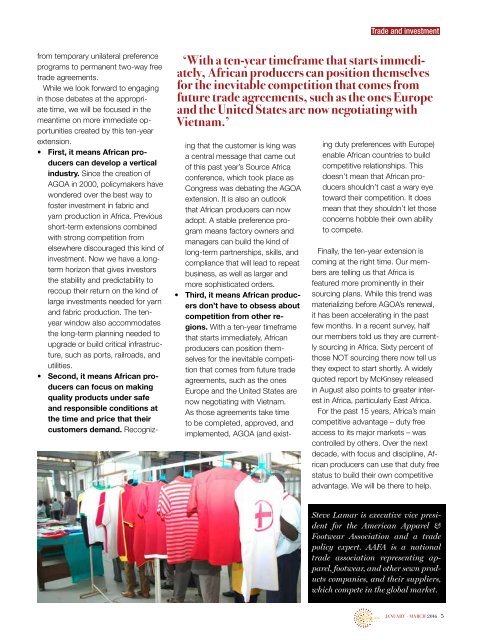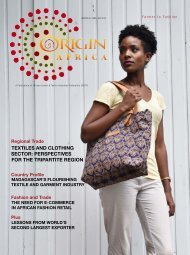Create successful ePaper yourself
Turn your PDF publications into a flip-book with our unique Google optimized e-Paper software.
Trade and investment<br />
‘With a ten-year timeframe that starts immediately,<br />
<strong>Africa</strong>n producers can position themselves<br />
for the inevitable competition that comes from<br />
future trade agreements, such as the ones Europe<br />
and the United States are now negotiating with<br />
Vietnam.’<br />
from temporary unilateral preference<br />
programs to permanent two-way free<br />
trade agreements.<br />
While we look forward to engaging<br />
in those debates at the appropriate<br />
time, we will be focused in the<br />
meantime on more immediate opportunities<br />
created by this ten-year<br />
extension.<br />
• First, it means <strong>Africa</strong>n producers<br />
can develop a vertical<br />
industry. Since the creation of<br />
AGOA in 2000, policymakers have<br />
wondered over the best way to<br />
foster investment in fabric and<br />
yarn production in <strong>Africa</strong>. Previous<br />
short-term extensions combined<br />
with strong competition from<br />
elsewhere discouraged this kind of<br />
investment. Now we have a longterm<br />
horizon that gives investors<br />
the stability and predictability to<br />
recoup their return on the kind of<br />
large investments needed for yarn<br />
and fabric production. The tenyear<br />
window also accommodates<br />
the long-term planning needed to<br />
upgrade or build critical infrastructure,<br />
such as ports, railroads, and<br />
utilities.<br />
• Second, it means <strong>Africa</strong>n producers<br />
can focus on making<br />
quality products under safe<br />
and responsible conditions at<br />
the time and price that their<br />
customers demand. Recognizing<br />
that the customer is king was<br />
a central message that came out<br />
of this past year’s Source <strong>Africa</strong><br />
conference, which took place as<br />
Congress was debating the AGOA<br />
extension. It is also an outlook<br />
that <strong>Africa</strong>n producers can now<br />
adopt. A stable preference program<br />
means factory owners and<br />
managers can build the kind of<br />
long-term partnerships, skills, and<br />
compliance that will lead to repeat<br />
business, as well as larger and<br />
more sophisticated orders.<br />
• Third, it means <strong>Africa</strong>n producers<br />
don’t have to obsess about<br />
competition from other regions.<br />
With a ten-year timeframe<br />
that starts immediately, <strong>Africa</strong>n<br />
producers can position themselves<br />
for the inevitable competition<br />
that comes from future trade<br />
agreements, such as the ones<br />
Europe and the United States are<br />
now negotiating with Vietnam.<br />
As those agreements take time<br />
to be completed, approved, and<br />
implemented, AGOA (and existing<br />
duty preferences with Europe)<br />
enable <strong>Africa</strong>n countries to build<br />
competitive relationships. This<br />
doesn’t mean that <strong>Africa</strong>n producers<br />
shouldn’t cast a wary eye<br />
toward their competition. It does<br />
mean that they shouldn’t let those<br />
concerns hobble their own ability<br />
to compete.<br />
Finally, the ten-year extension is<br />
coming at the right time. Our members<br />
are telling us that <strong>Africa</strong> is<br />
featured more prominently in their<br />
sourcing plans. While this trend was<br />
materializing before AGOA’s renewal,<br />
it has been accelerating in the past<br />
few months. In a recent survey, half<br />
our members told us they are currently<br />
sourcing in <strong>Africa</strong>. Sixty percent of<br />
those NOT sourcing there now tell us<br />
they expect to start shortly. A widely<br />
quoted report by McKinsey released<br />
in August also points to greater interest<br />
in <strong>Africa</strong>, particularly East <strong>Africa</strong>.<br />
For the past 15 years, <strong>Africa</strong>’s main<br />
competitive advantage – duty free<br />
access to its major markets – was<br />
controlled by others. Over the next<br />
decade, with focus and discipline, <strong>Africa</strong>n<br />
producers can use that duty free<br />
status to build their own competitive<br />
advantage. We will be there to help.<br />
Steve Lamar is executive vice president<br />
for the American Apparel &<br />
Footwear Association and a trade<br />
policy expert. AAFA is a national<br />
trade association representing apparel,<br />
footwear, and other sewn products<br />
companies, and their suppliers,<br />
which compete in the global market.<br />
JANUARY - MARCH 2016 5



